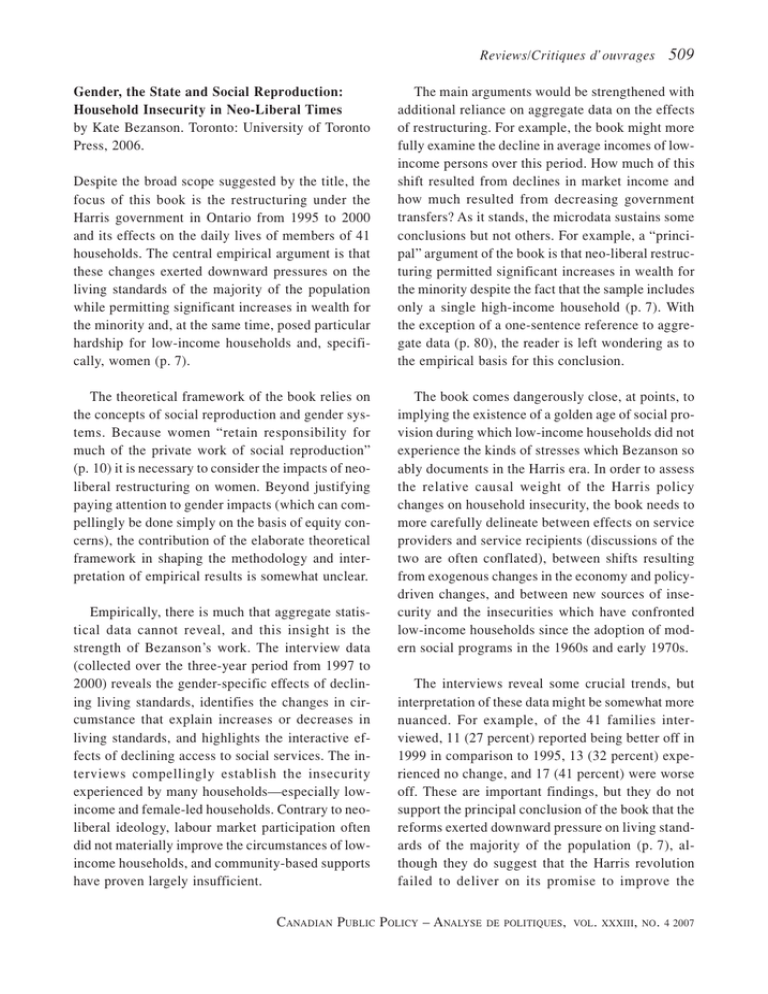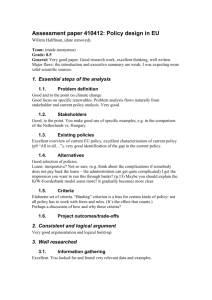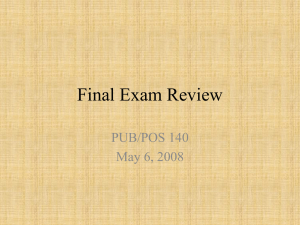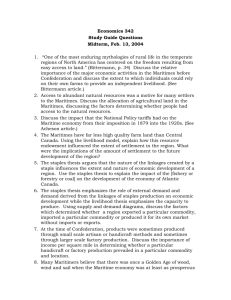509
advertisement

Reviews/Critiques d’ouvrages Gender, the State and Social Reproduction: Household Insecurity in Neo-Liberal Times by Kate Bezanson. Toronto: University of Toronto Press, 2006. Despite the broad scope suggested by the title, the focus of this book is the restructuring under the Harris government in Ontario from 1995 to 2000 and its effects on the daily lives of members of 41 households. The central empirical argument is that these changes exerted downward pressures on the living standards of the majority of the population while permitting significant increases in wealth for the minority and, at the same time, posed particular hardship for low-income households and, specifically, women (p. 7). The theoretical framework of the book relies on the concepts of social reproduction and gender systems. Because women “retain responsibility for much of the private work of social reproduction” (p. 10) it is necessary to consider the impacts of neoliberal restructuring on women. Beyond justifying paying attention to gender impacts (which can compellingly be done simply on the basis of equity concerns), the contribution of the elaborate theoretical framework in shaping the methodology and interpretation of empirical results is somewhat unclear. Empirically, there is much that aggregate statistical data cannot reveal, and this insight is the strength of Bezanson’s work. The interview data (collected over the three-year period from 1997 to 2000) reveals the gender-specific effects of declining living standards, identifies the changes in circumstance that explain increases or decreases in living standards, and highlights the interactive effects of declining access to social services. The interviews compellingly establish the insecurity experienced by many households—especially lowincome and female-led households. Contrary to neoliberal ideology, labour market participation often did not materially improve the circumstances of lowincome households, and community-based supports have proven largely insufficient. 509 The main arguments would be strengthened with additional reliance on aggregate data on the effects of restructuring. For example, the book might more fully examine the decline in average incomes of lowincome persons over this period. How much of this shift resulted from declines in market income and how much resulted from decreasing government transfers? As it stands, the microdata sustains some conclusions but not others. For example, a “principal” argument of the book is that neo-liberal restructuring permitted significant increases in wealth for the minority despite the fact that the sample includes only a single high-income household (p. 7). With the exception of a one-sentence reference to aggregate data (p. 80), the reader is left wondering as to the empirical basis for this conclusion. The book comes dangerously close, at points, to implying the existence of a golden age of social provision during which low-income households did not experience the kinds of stresses which Bezanson so ably documents in the Harris era. In order to assess the relative causal weight of the Harris policy changes on household insecurity, the book needs to more carefully delineate between effects on service providers and service recipients (discussions of the two are often conflated), between shifts resulting from exogenous changes in the economy and policydriven changes, and between new sources of insecurity and the insecurities which have confronted low-income households since the adoption of modern social programs in the 1960s and early 1970s. The interviews reveal some crucial trends, but interpretation of these data might be somewhat more nuanced. For example, of the 41 families interviewed, 11 (27 percent) reported being better off in 1999 in comparison to 1995, 13 (32 percent) experienced no change, and 17 (41 percent) were worse off. These are important findings, but they do not support the principal conclusion of the book that the reforms exerted downward pressure on living standards of the majority of the population (p. 7), although they do suggest that the Harris revolution failed to deliver on its promise to improve the CANADIAN PUBLIC POLICY – ANALYSE DE POLITIQUES, VOL . XXXIII, NO . 4 2007 510 Reviews/Critiques d’ouvrages positions of families generally. Furthermore, of 19 low-income households, 7 (37 percent) improved their position, 1 (5 percent) remained unchanged, and 11 (58 percent) were worse off. In contrast, only 3 (14 percent) of the 21 medium-income households improved their situation, 6 (28 percent) were worse off, and 12 (57 percent) remained the same. Lowincome families were strikingly more subject to change than medium-income families—being both much more likely to improve their positions but also much more likely to become worse off. Low-income families appear to have been pressed to either find a way to improve their situation or face even more straightened circumstances. One may strongly disagree with the moral underpinnings of this policy approach; however, it seems naïve to assume that the relevant policy-makers would have interpreted the results for low-income households as indicative of policy failure. Finally, there are difficult methodological problems. Most notably, Bezanson rejects low-income households’ reporting of hours of unpaid work on the basis that these reports were “inconsistent with the stories they told” (p. 127) and that respondents CANADIAN PUBLIC POLICY – ANALYSE were unable to “conceptualize their unpaid work as labour” (p. 128). Bezanson thus relies on anecdotal individual family experiences in specific service areas (health care, education, social assistance) to “suggest that unpaid work increased as funding cuts and policy changes took hold” (p. 127). This methodological challenge appears relatively serious as a central conceptual component of Bezanson’s approach is the role of unpaid, primarily female-provided, labour in managing the contradictions between neo-liberalism and social reproduction, and her claim that this work has increased to unsustainable levels. Nevertheless, despite the challenges confronting this type of empirical work, it remains critical to our understanding of policy restructuring. Perhaps the most important contribution of the work is to provide a compelling and forceful reminder to those who make and study policy that social policy has important and direct impacts for real people and that these impacts are often experienced in very different ways depending on class and gender. GERARD W. BOYCHUK, Department of Political Science, University of Waterloo DE POLITIQUES, VOL . XXXIII, NO . 4 2007 Reviews/Critiques d’ouvrages Lessons of Disaster: Policy Change after Catastrophic Events by Thomas A. Birkland. Washington, DC: Georgetown University Press, 2007. As they try to analyze and explain how politicians respond to the various crises of our time, policy analysts can never control the merciless unfolding of events. This is one of the most obvious lessons of Lessons of Disaster. Thomas A. Birkland began this book in the aftermath of 9/11. He set out to compare the responses of the American federal government to terrorist attacks, aviation safety issues, earthquakes, and hurricanes. Before he was finished, Hurricane Katrina struck New Orleans and President Bush decided to attack Iraq. Lessons of Disaster is a clear, readable, and successful attempt to link government responses to disasters with the established literature on the policy process, especially in the United States. Birkland is especially interested in the impact of “focusing events,” of which 9/11 has surely become the archetypal example. One of the few annoying aspects of the book is his attempt to quantify the importance of 9/11. Do we really need Figure 2.1 (p. 48) showing that references to “terrorism” spiked dramatically in the New York Times and in Congress during late 2001? This is the kind of enterprise that gives quantitative social science a bad name, especially among practitioners who often find academic analyses less than helpful when they search our work looking for better policy alternatives. Fortunately, Birkland shows himself capable of straying from some of his original methodological plans. In the final chapter he introduces Hurricane Katrina into his analysis, even though it had yet to occur when he started his original project. Some of 511 the most interesting and perceptive analysis in the entire book is contained in Birkland’s discussion of how the creation of the Department of Homeland Security—with its emphasis on fighting domestic terrorism—had the effect of reducing the capacity of the American federal government to respond to natural disasters such as Katrina. Using John Kingdon’s vocabulary and framework—as he does throughout much of the book—Birkland refers to the weakness of the federal response to Katrina as a “spillover effect” from its response to the 9/11 disaster. While Birkland is interested in the creation of the Department of Homeland Security as a response to disaster, he does not mention the invasion of Iraq in this book even though President Bush indicated that the Iraq invasion was a deliberate policy response to 9/11. Invading Iraq was an attempt to reorganize the Middle East by eliminating breeding grounds for terrorists, just as reorganizing the federal government by creating the Department of Homeland Security was meant to assist in the domestic battle against terrorists. Clearly Birkland cannot write about everything, but thinking about why Iraq (or Afghanistan) was not included in the analysis causes one to question the all-too-neat categories and boxes that Birkland is apt to employ. Maybe 9/11 itself transcends the “disaster” category, just as the killing of Archduke Ferdinand is inadequately described as a mere “assassination.” For Birkland, 9/11 was a “disaster” that produced “spillover effects.” This is one way of viewing 9/11, but it is unlikely to be the way it will be viewed by those who write the history of the twenty-first century. ANDREW SANCTON, Department of Political Science, University of Western Ontario CANADIAN PUBLIC POLICY – ANALYSE DE POLITIQUES, VOL . XXXIII, NO . 4 2007 512 Reviews/Critiques d’ouvrages Faith, Hope and Jobs: Welfare to Work in Los Angeles by Stephen V. Monsma and J. Christopher Soper. Washington, DC: Georgetown University Press, 2006, 228 pp. In the US in recent years, faith-based groups have increasingly partnered with the government to provide essential social services. Other groups also partner with the government, namely secular nonprofit and for-profit organizations. Who knows how effective faith-based organizations are in meeting the needs of those seeking to move from welfare to economic self-sufficiency? Do faith-based organizations provide better outcomes? Stephen Monsma and Christopher Soper tackle these questions by surveying the clients of 17 different welfare-to-work programs in urban Los Angeles County. These 17 programs are classified as government (four), forprofit (two), non-profit/secular (three), faith-based segmented (religious elements are implicit; four), and faith-based integrated (religious elements are explicit; four). The authors chose Los Angeles County because they were located there at the time of their research, and they point out that Los Angeles County presents a large, diverse urban centre which is home to 8 percent of the US welfare roll and accounts for 14 percent of total US welfare expenditure. The question of program “effectiveness” for welfare-to-work programs is not only interesting but especially urgent in the US where families reach their maximum five-year eligibility time limit for receiving cash assistance (for a detailed account of the differences between welfare in the US and welfare in Canada, see Quaid 2002). considered effective or ineffective? She had not found a job, not even a part-time, minimum wage job. She had not realized the hoped for ultimate or intermediate outcomes. But she had more confidence in herself and she had acquired key skills needed to go out and compete for employment. She had experienced positive enabling outcomes as we have termed them. One could even argue that this was a more positive outcome than a acquiring a minimum wage, no-benefits job that in any case might not last more than a few months. (p. 164) Definition problems and boundary issues prevent the authors from ever answering their own questions. Conclusions are tentative: “faith-based programs—and especially integrally faith-based programs—may be particularly suitable for those who are personally religious, but . . . the nonreligious also can do well in such programs. The differences were not as clear or as strong as we had anticipated” (pp. 170-1). The authors struggle with the definition of “effectiveness” throughout the entire book. To give you an idea of the endless questioning that goes on, one client who had completed a faith-based/integrated program and still had not found a job, but said the program was “great,” led the authors to ponder: As the reader plods through the agonizing details of the questionnaire and telephone interviews and as religion fades into the background, one finding does appear to emerge; for-profit organizations outperform the other categories of welfare-to-work providers, (and should therefore be allocated more government funding): “On almost all of our intermediate and ultimate outcome measures the forprofit clients experienced better outcomes than did the clients of the other four types of programs, often significantly so.” However, the authors go on to qualify: “Yet, a word of caution is in order. Only two for-profit programs were included in our study and they did not outperform the other program types consistently or by huge margins. In fact, they did worse than the other programs by some of our measures” (p. 175). Maybe the book should have been entitled Faith (religious), Hope (non-profit), Charity (government) and Business (for-profit): Who Delivers the Goods on Welfare-to-Work Programs in Los Angeles? Should such a client be judged to be a program success or failure? Should her program be Random survey details are scattered throughout the book, making for a very hard read. In the final CANADIAN PUBLIC POLICY – ANALYSE DE POLITIQUES, VOL . XXXIII, NO . 4 2007 Reviews/Critiques d’ouvrages chapter, even the authors themselves admit: “The preceding chapters have presented a maze of specific findings; so many, in fact, that both we as researchers and our readers court the danger of being overwhelmed by an avalanche of specific findings with no apparent pattern to them” (p. 164). My thoughts precisely. Despite their lack of focus, the authors conclude the book with advice and recommendations for three different groups: policymakers, program managers, and researchers. Policy-makers, for example, should increase funding to faith-based programs despite no conclusive evidence of superior performance relative to the other programs. Program managers might want to borrow from other programs and collaborate with 513 others. Researchers might think of obtaining a larger sample and study more areas than Los Angeles. Not really much to draw from here. Just because the authors collected a lot of information, does not mean that it had to be stretched into a book. It felt more like a very long journal article. REFERENCE Quaid, M. 2002. Workfare: Why Good Social Policy Ideas Go Bad. Toronto: University of Toronto Press. MAEVE QUAID, Business Administration Program, Trent University CANADIAN PUBLIC POLICY – ANALYSE DE POLITIQUES, VOL . XXXIII, NO . 4 2007 514 Reviews/Critiques d’ouvrages The Nisga’a Treaty: Polling Dynamics and Political Communication in Comparative Context by J. Rick Ponting. Peterborough, ON: Broadview Press, 2006. ing treaty negotiations. Absent is an overt assessment of the extent to which the government’s commitment and ability to proceed—factors relevant to the final outcome—were enhanced by the data showing support for the treaty. J. Rick Ponting has prepared a constructive and original volume on the British Columbia government’s public opinion research and advertising in support of the Nisga’a Treaty. While the book reveals little about the determination of the policy in the late 1990s, or the treaty’s details, it does provide an informative and sometimes fascinating account of how opinion research was employed to help develop the tactics and strategy for publicizing and promoting the treaty. While Ponting does not make extensive use of his research on the federal government’s activities in support of the treaty, he includes a chapter on the Australian government’s polling on reconciliation with indigenous people. As in BC, opinion research did not determine policy in Australia. The material on Australia is smoothly integrated, and the comparison is valuable because the BC government was more sympathetic to Aboriginal interests and surer of its goals. To his credit, Ponting examines the roles of focus groups as well as polls, questionnaire construction, and unelected advisors. He also discusses the group dynamics at play and the importance of communications in high-profile policy areas. Elite interviews and government documents inform the analysis. The book, however, rarely addresses normative questions; indeed, Ponting uses the word “normative” to refer to the establishment of norms, rather than being concerned with values. Ponting believes that opinion research was used sensibly and aided the government’s communications efforts. He writes that “the advertising campaign was essentially the raison d’être of the polling campaign” (p. 79). Thus, rather than determining policy as many observers would expect, opinion research affected communications tactics and strategy, including the frequency and placement of advertising. Polling influenced the decisions to include Nisga’a spokespeople in advertising and not to rebut opponents’ claims that the treaty would create “race-based government” (p. 79). As well, opinion research contributed to a shift in the style of advertising to avoid appearing overly slick, emotional, and defensive. Polling showed that supporters of the Nisga’a Treaty consistently outnumbered opponents. Still, the BC government devoted unusual efforts and resources to selling the treaty, by polling and advertising extensively. This was partly because NDP Premier Glen Clark made it a personal priority. Moreover, officials sought to boost the government’s popularity; they also thought strong public support for the treaty might sway MLAs in an anticipated free vote. Hopes of dividing the opposition Liberals also played a part. Ponting indicates that the government’s advocacy, and the design of the treaty, were not driven by polls. Public opinion, but not specific data, was cited dur- CANADIAN PUBLIC POLICY – ANALYSE Ponting draws on Herbert Blumer’s notion that the study of public opinion should “begin with those who have to act on public opinion” (p. 13). However, the use of secondary literature is thin. In particular, the book lacks an adequate attempt to include insights from literature on Canadian government communications (e.g., studies by Robert Bernier and Jonathan Rose) and polling for American presidents (e.g., research by Shoon Murray and Michael Towle). DE POLITIQUES, VOL . XXXIII, NO . 4 2007 Reviews/Critiques d’ouvrages Despite these gaps, the final chapter offers thoughtful observations. Although it is somewhat unclear how much Ponting thinks this case study demonstrates, he notes the risk of generalizing from an atypical case study. Since much government polling is less political than that on the Nisga’a Treaty, this is especially germane to the broadly correct observation that the creation and results of poll questions “will be viewed through a political lens” (p. 123). Nevertheless, the passages on the mystique of polling and pollsters’ interests in preserving this mystique are particularly intriguing. Ponting also observes that government officials’ uncertainty affects decisions whether or not to poll; he might have added that they often know the state of public opinion but still desire opinion research to help communicate policy. 515 Two additional points deserve noting. The term “push polling” is employed to characterize conventional polls with loaded questions (pp. 108, 131); in fact, the concept should be reserved for pretend polls used for campaigning or advocacy. As well, some information in the appendices—such as the amount of government advertising in specific newspapers—could have been exchanged for more description and analysis earlier in the book. While this change and a more thorough literature review would have been welcome, this fine piece of research should be applauded. Hopefully others will pursue similar projects in the near future. CHRISTOPHER P AGE, Department of Political Science, Carleton University CANADIAN PUBLIC POLICY – ANALYSE DE POLITIQUES, VOL . XXXIII, NO . 4 2007 516 Reviews/Critiques d’ouvrages Visiting Grandchildren: Economic Development in the Maritimes by Donald J. Savoie. Toronto: University of Toronto Press, 2006. Donald Savoie provides an excellent analysis of the political dynamics of regional development programs in Canada over the last half century. His central argument is that J.A. Macdonald modelled Canada’s constitution on the strong unitary state of Britain, resulting in a political structure that systematically subordinates the economic interests of the more sparsely populated peripheral provinces to the interests of the densely populated central provinces. The concentration of policy-making, government offices, and agencies in Ottawa exacerbates the problem. Problems and concerns about the economies of southern Ontario and Quebec are considered national problems while the same problems elsewhere are deemed regional problems. This discussion of the politics of regional development is persuasive and up to date. Although several chapters repeat information previously published in 1992, the detailed discussion of the evolution of development policies is taken up to the government of Paul Martin, which ended in the publication year of this volume. Even Stephen Harper’s views as leader of the opposition are included. While the book provides excellent political analysis, the economic analysis is far less satisfactory. Savoie has not kept up with the literature on the economic history of the Maritimes. He repeats the old story that the Maritimes region had a Golden Age that ended with Confederation. He seems unaware of the literature indicating fundamental weaknesses in the pre-Confederation domestic economy. Although the shipping industry of the Maritimes was flourishing at Confederation, the region lacked the economic strength Ontario derived from its rich agricultural resources. Savoie also fails to note that Maritime entrepreneurs initially responded with alacrity to the tariff regime of the National Policy, CANADIAN PUBLIC POLICY – ANALYSE for better or worse shifting resources from shipping and shipbuilding into manufacturing industries in the protected sectors. Manufacturing in the Maritimes grew substantially from Confederation into the early twentieth century. The chapter on economic theories, like the chapter on economic history, cites only a few sources written after the early 1990s. As a result Savoie omits discussion of the “new economic geography,” which provides a theoretical framework for understanding the distribution of economic activities across space. This new theoretical work has not been applied to regional development in Canada, and it is unfair to criticize Savoie, who is primarily a political scientist, for not interpreting the regional development policy through the lens of this relatively new theory. Yet if Savoie had been more actively reading in the field, he might well have found Krugman’s accessible Geography and Trade extremely helpful in understanding the pattern of Canadian development. While Savoie provides a political analysis of the creation and implementation of regional development policies, he does not analyze their effectiveness. He does not even explicitly define their goals. However, the goals that he implies raise interesting issues. The title of the book implies one goal. It came from a comment made by Harper while trying to repair the political damage caused by his earlier statement that the Maritimes were characterized by a climate of defeat. He claimed that his policies would transform the Maritimes from a place where people come to visit their grandparents to a place where people come to visit their grandchildren. The implication is that a prosperous region has net immigration. Savoie also refers to the weak manufacturing base in the Maritimes, implying that effective regional development policies would provide a balanced manufacturing base. Finally, he refers to policies implemented in the Maritimes as directed toward regions of slow growth. DE POLITIQUES, VOL . XXXIII, NO . 4 2007 Reviews/Critiques d’ouvrages Examination of these implied goals of regional development policies reflects confusion about the nature of regional development. First, the Maritimes has not been a region of slow growth for the last half century. It has been growing more quickly than the rest of Canada during the post-war era, narrowing but not closing the very large gap in incomes found in 1950. Second, all the regions of a nation cannot have net domestic immigration; internal population movement is a zero sum game. Finally, the new economic geography and the pattern of economic activity observed around the world demonstrate that economic activity in developed nations is rarely evenly distributed across space. Economic activity that is not tied to natural resources tends to cluster in cities, and those cities cluster within a relatively constricted geographic territory. What are realistic goals of regional development policies? Since the clustering of economic activities appears to be the result of fundamental economic forces, attempting to disperse economic activity evenly across regions is likely to be costly and futile. A policy of regional development that appeals to many is the promotion of the healthy development of specialized regional economies in which mobility of capital and labour ensures equality of incomes and economic opportunity. Such a vision of development ignores a fundamental reality. Regions are unlikely to reach an equilibrium in which migration ceases because incomes have equalized. Those regions specialized in economic sectors experiencing above average growth require a more rapidly growing labour force, and therefore above average wages that attract workers from other regions. In contrast, most primary products have a low income elasticity of demand (lobster and oil are currently exceptions). As incomes rise, the share of primary production in total output shrinks. If the proportion of workers in that sector does not fall, their incomes decline. Low incomes induce them to leave the sector, but so long as the 517 primary sector grows more slowly than the economy as a whole, the wages of primary sector workers must be lower than wages elsewhere. The gap in wages must be substantial since migration is costly, and the pecuniary costs are trivial compared to the psychic costs of separating people from families and friends and disrupting children’s lives. The tendency of footloose economic activity to cluster in one general area implies a perpetual problem of regional disparities. These disparities are not the result of some defect in the poorer regions, such as lack of entrepreneurship, a culture of defeat, or inadequate supplies of capital. They are the result of capitalist market forces that create the tendency toward regional specialization. The development policies described by Savoie were economically confused responses to urgent economic problems and real hardships. Very likely, some policies were harmful, some merely wasteful, and some absolutely essential to the well-being of the less favoured regions. Without assistance in road building, electrification, and funding for education and health care, narrowing the gap in incomes during the last half century might have been far more difficult. We need a book that systematically evaluates regional policies. We also need to reactivate the academic field of regional economic development with the new tools available, so that better policies that reduce the hardships caused by economic forces can be devised. In spite of its omissions, Visiting Grandchildren is an important contribution to our understanding of the politics of regional development policy in Canada. Savoie confines his policy suggestions to changes in political structure, and these seem sound to this economist. He recommends an effective Senate that represents regional interests, far more political coordination among the Maritime provinces, and the systematic decentralization of federal policymaking and of much administration. He urges the federal government to encourage the economies of each region of Canada, identifying Central Canada CANADIAN PUBLIC POLICY – ANALYSE DE POLITIQUES, VOL . XXXIII, NO . 4 2007 518 Reviews/Critiques d’ouvrages as one region, rather than promoting one “national” economy that is the economy of Central Canada. Whatever the patterns of regional development that emerge as the new knowledge economy replaces the industrial economy, these suggestions are likely to result in a better response to the economic challenges of all of the regions of Canada. MARILYN GERRIETS, Department of Economics, St. Francis Xavier University CANADIAN PUBLIC POLICY – ANALYSE DE POLITIQUES, VOL . XXXIII, NO . 4 2007




